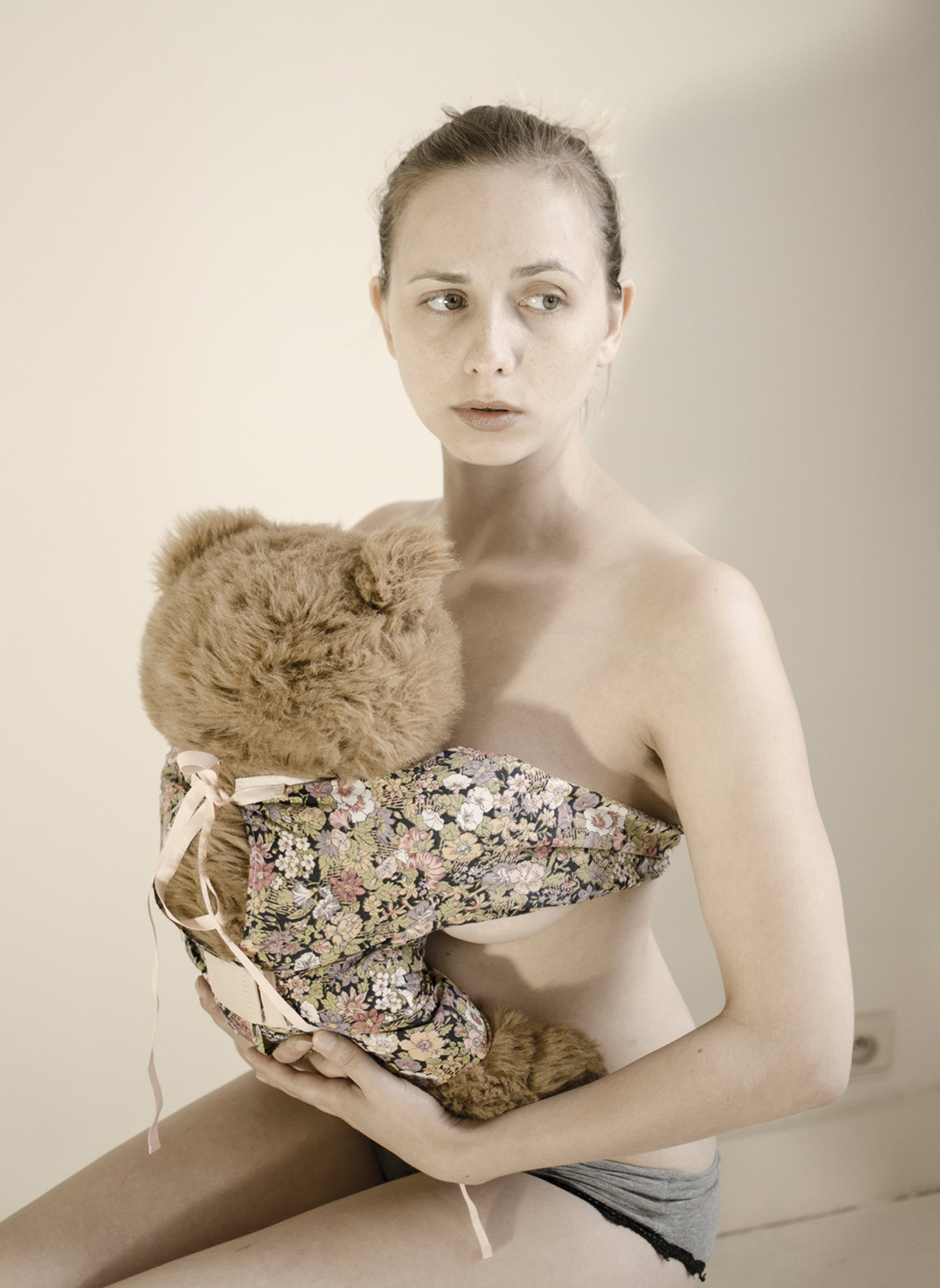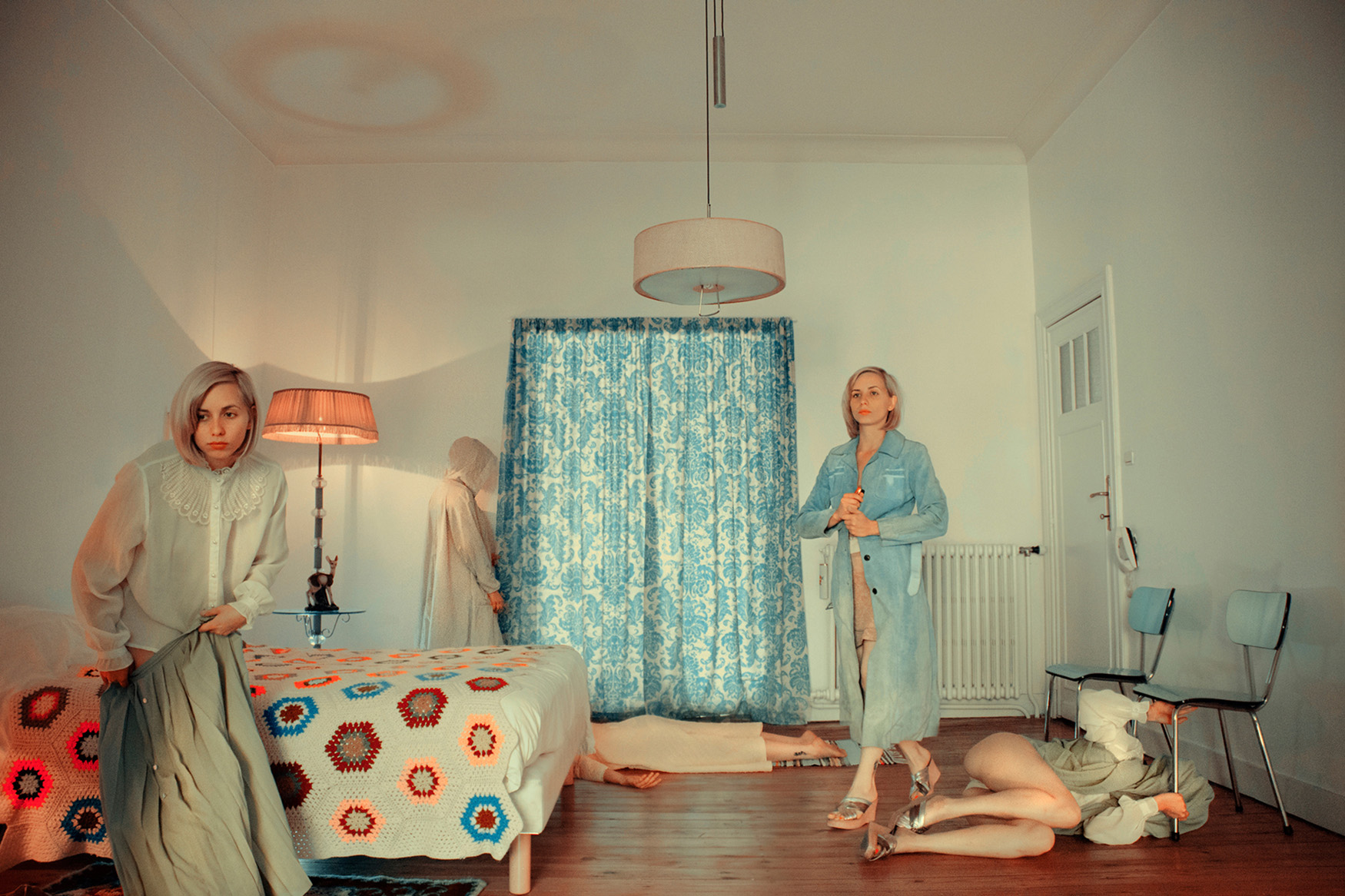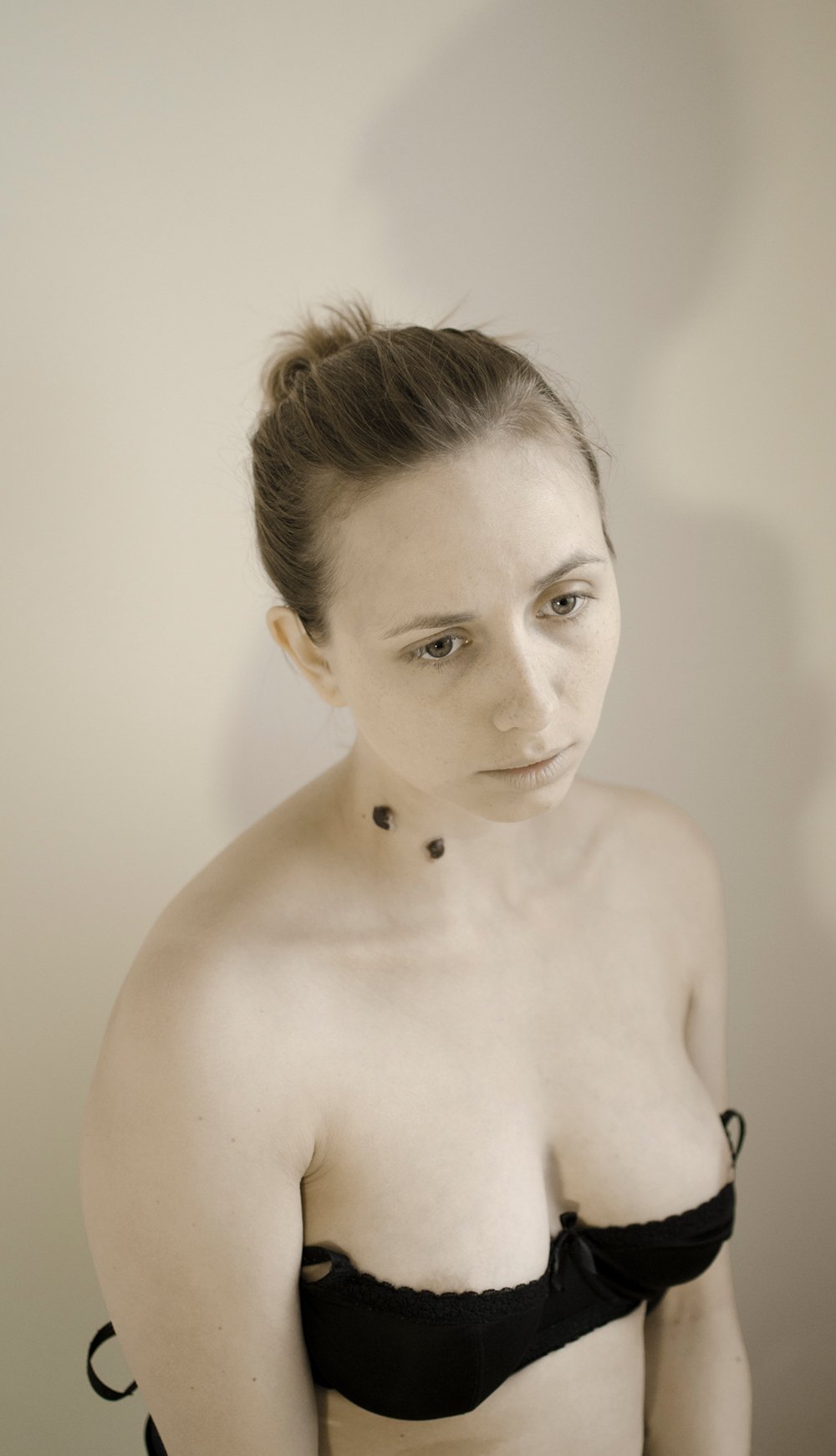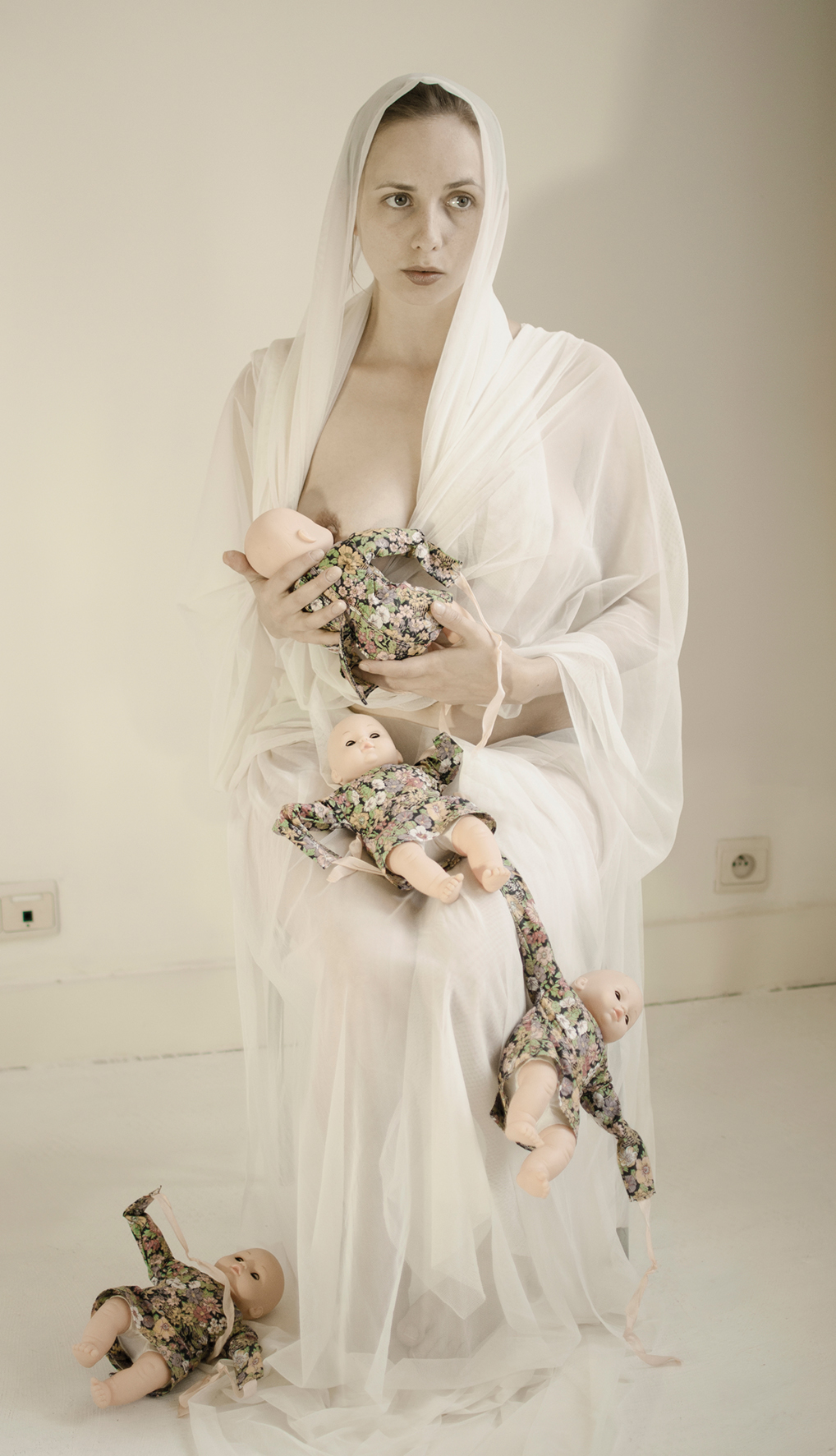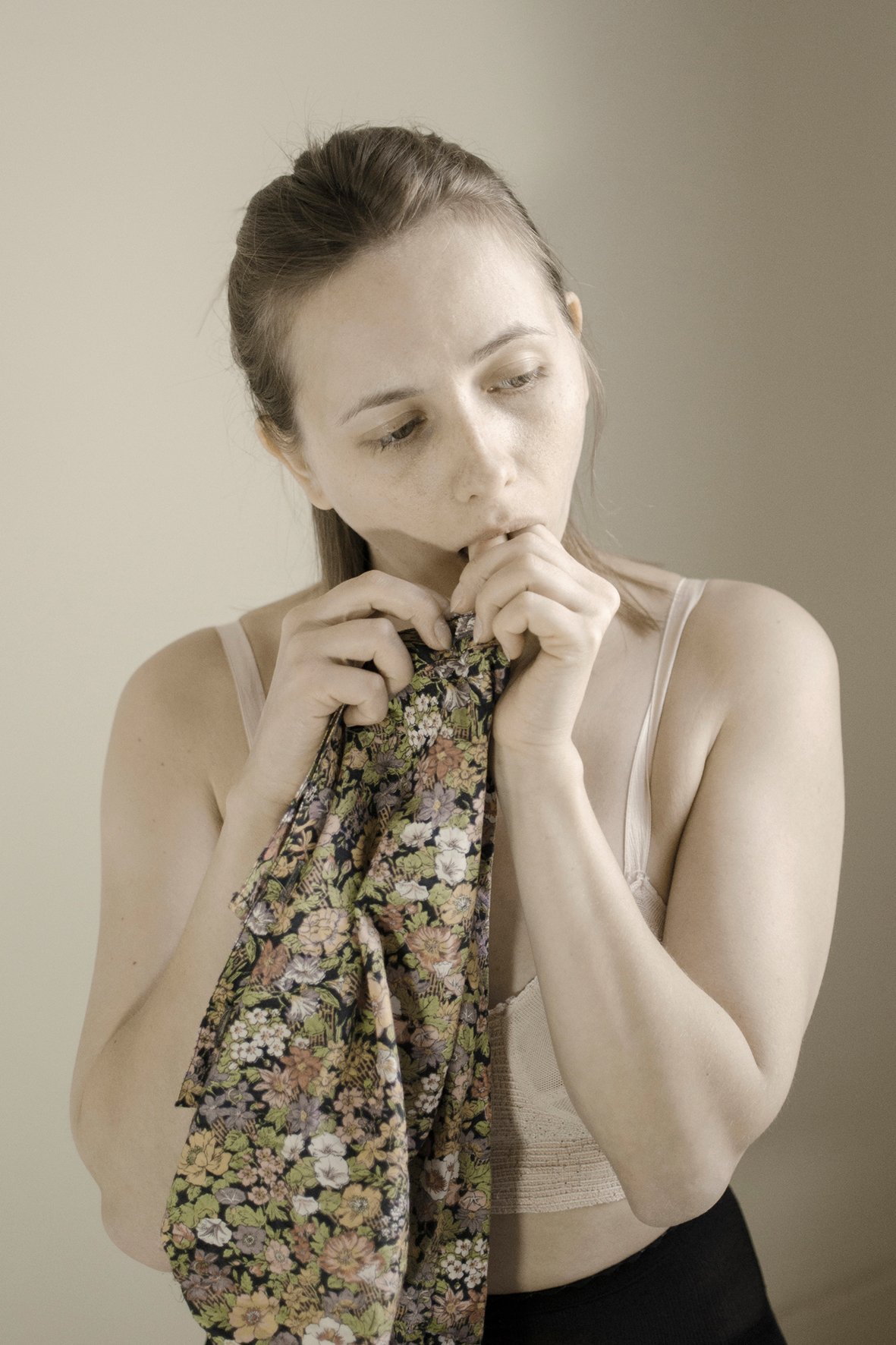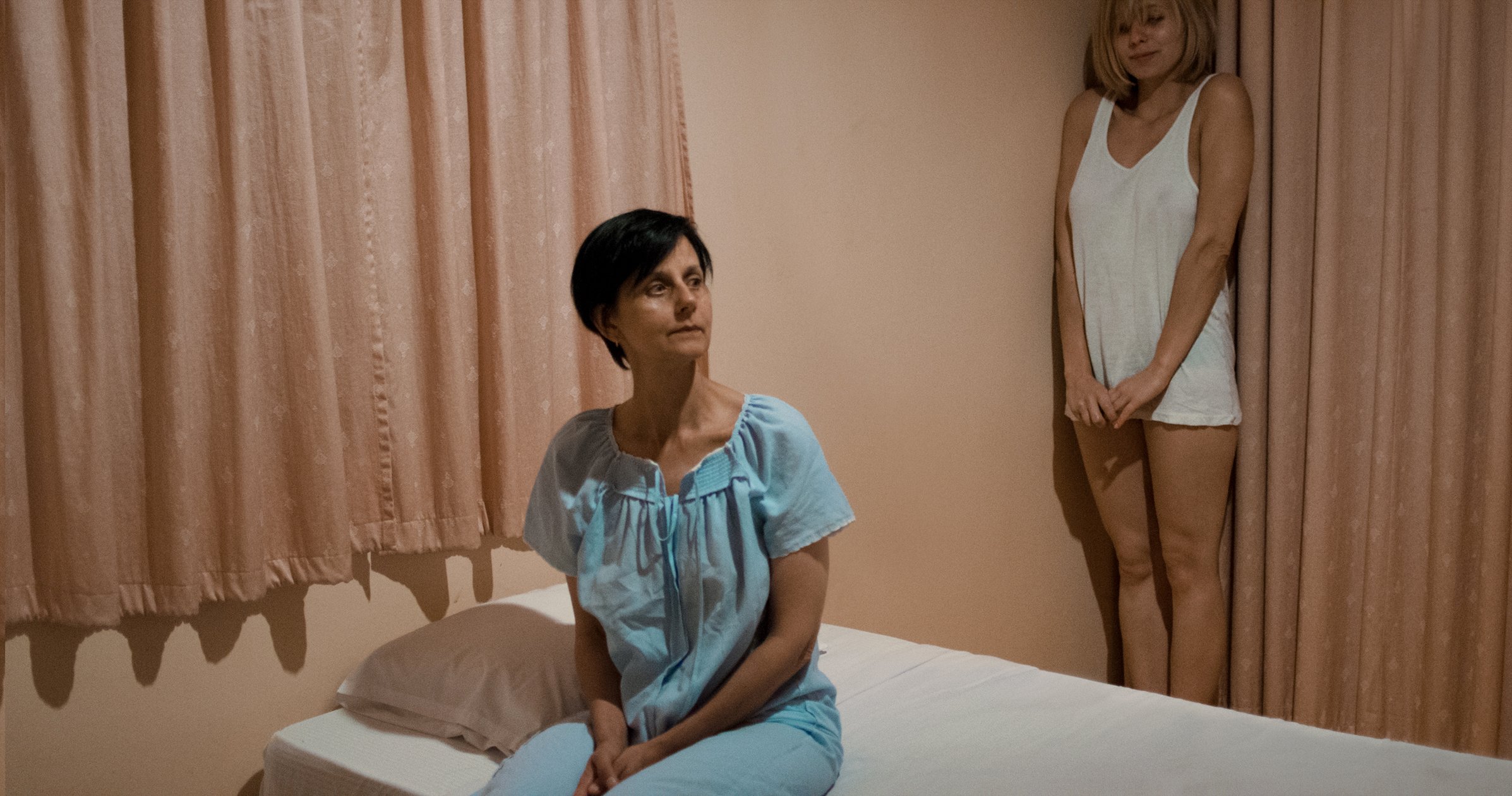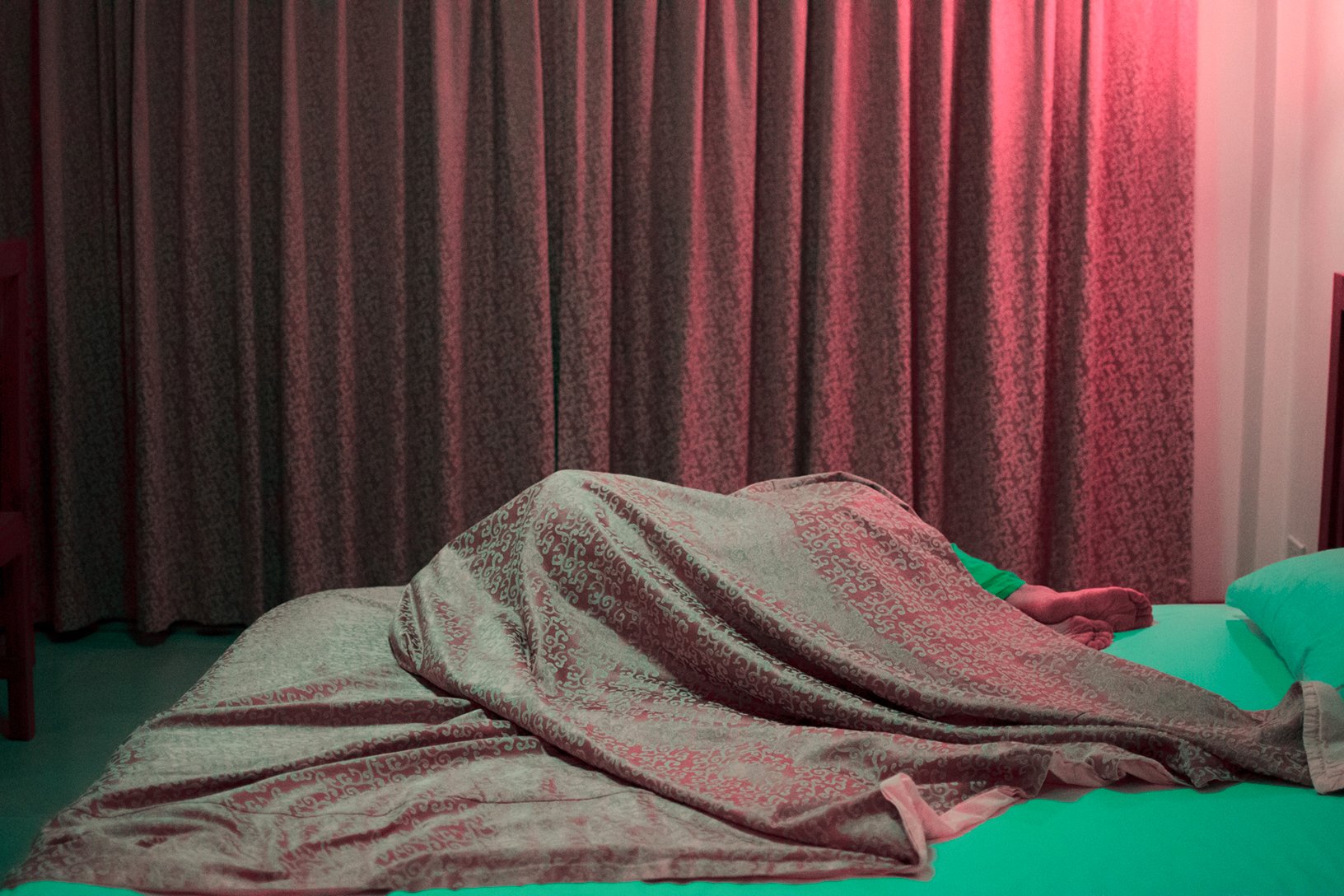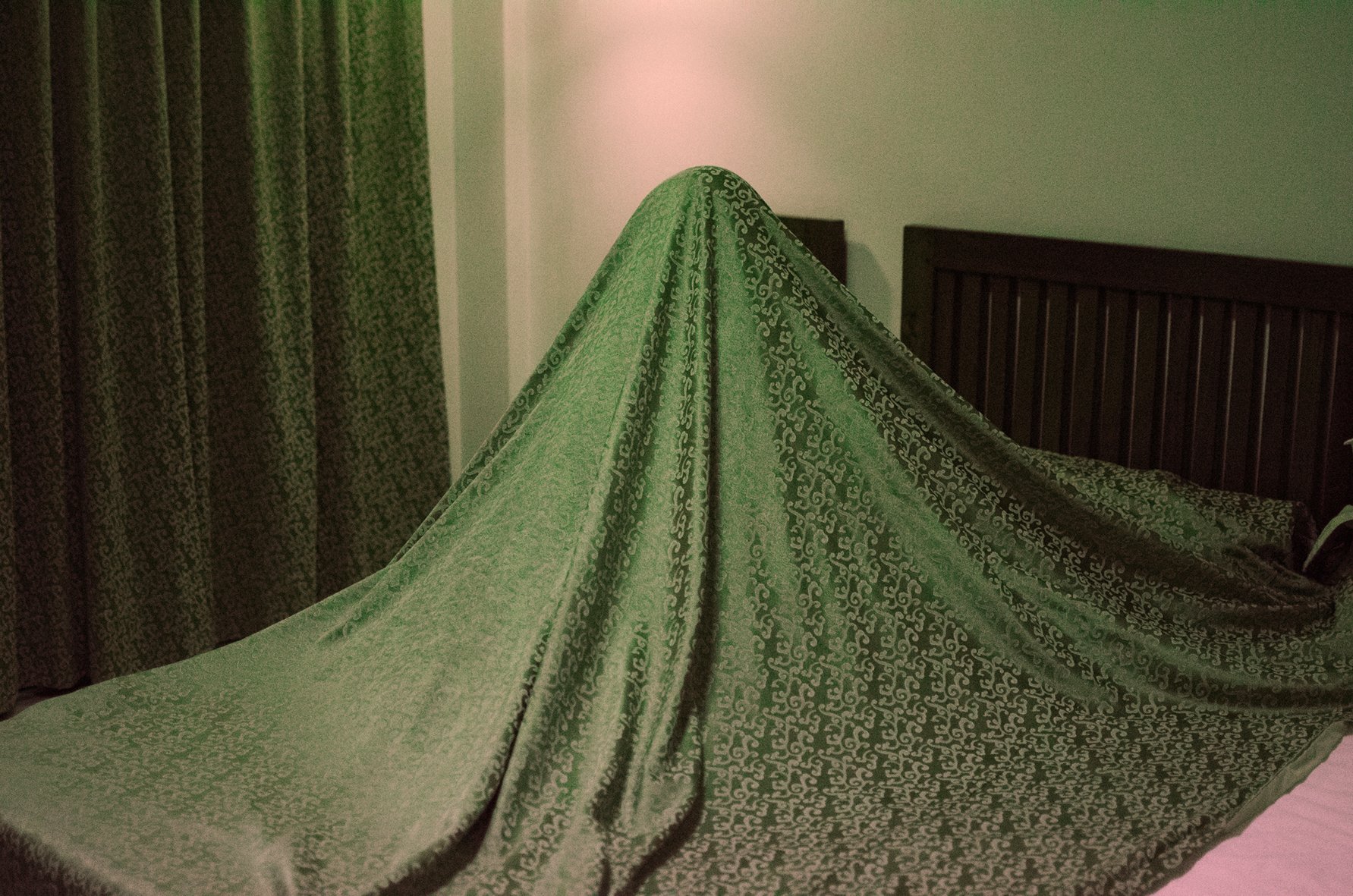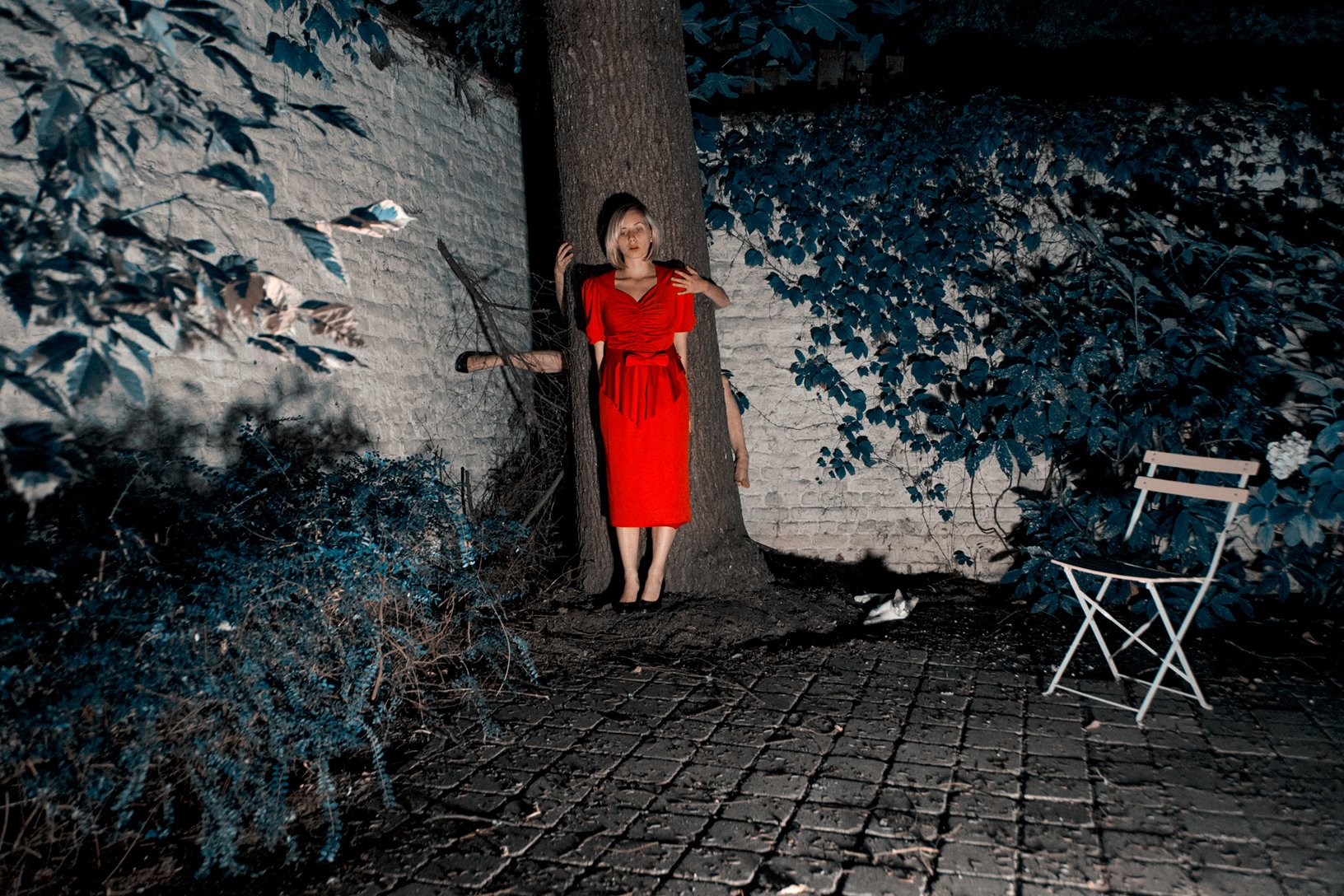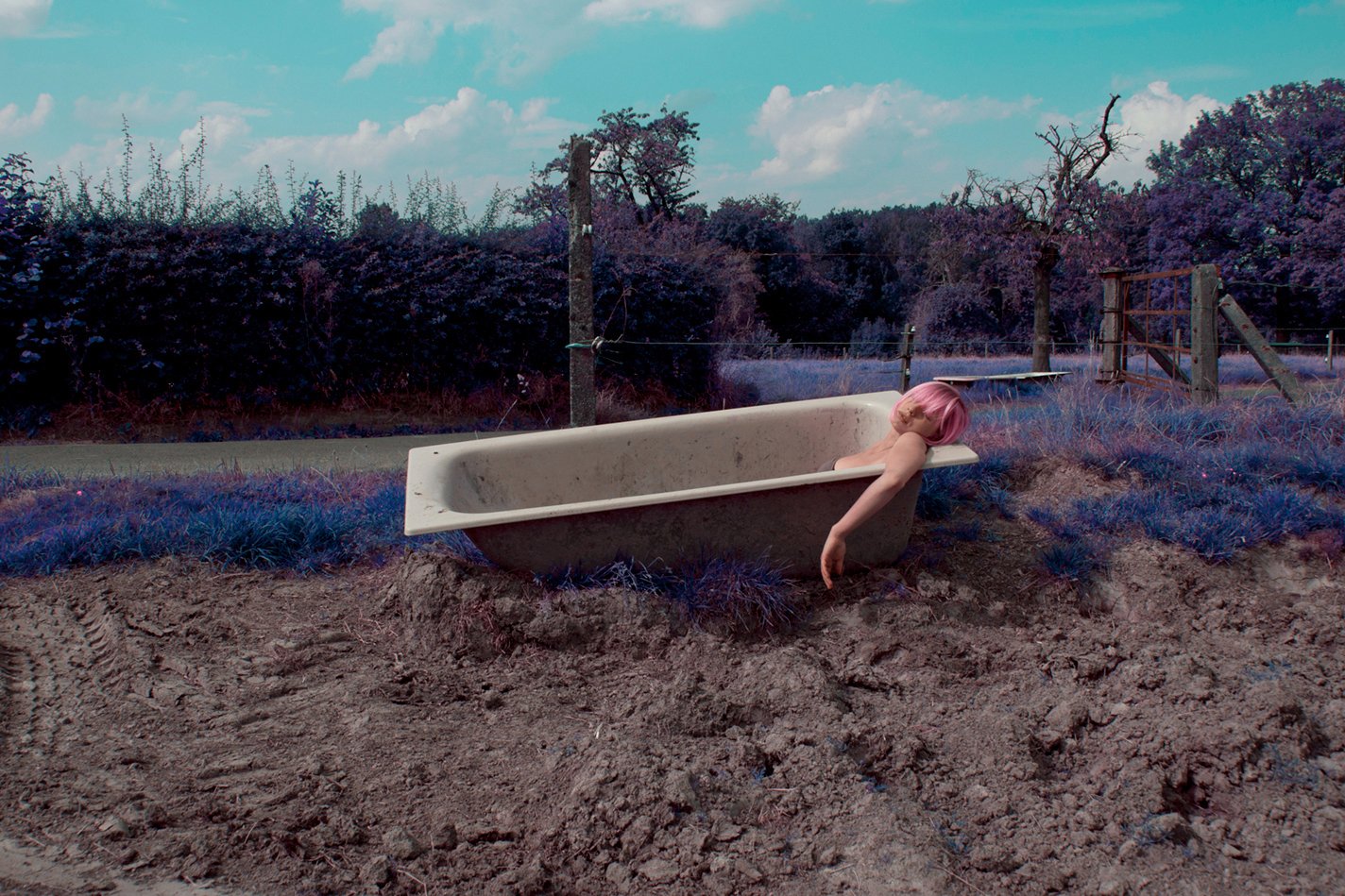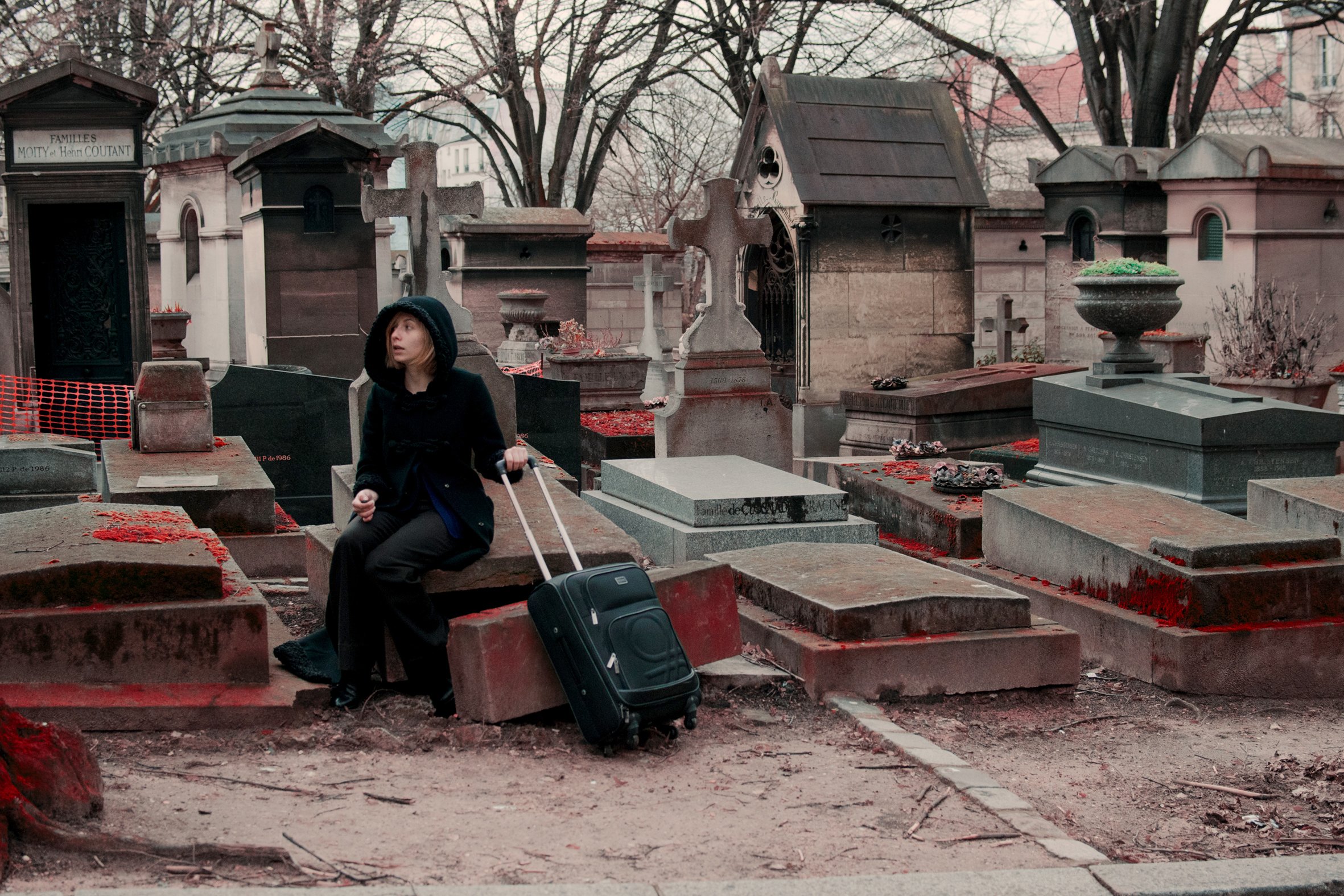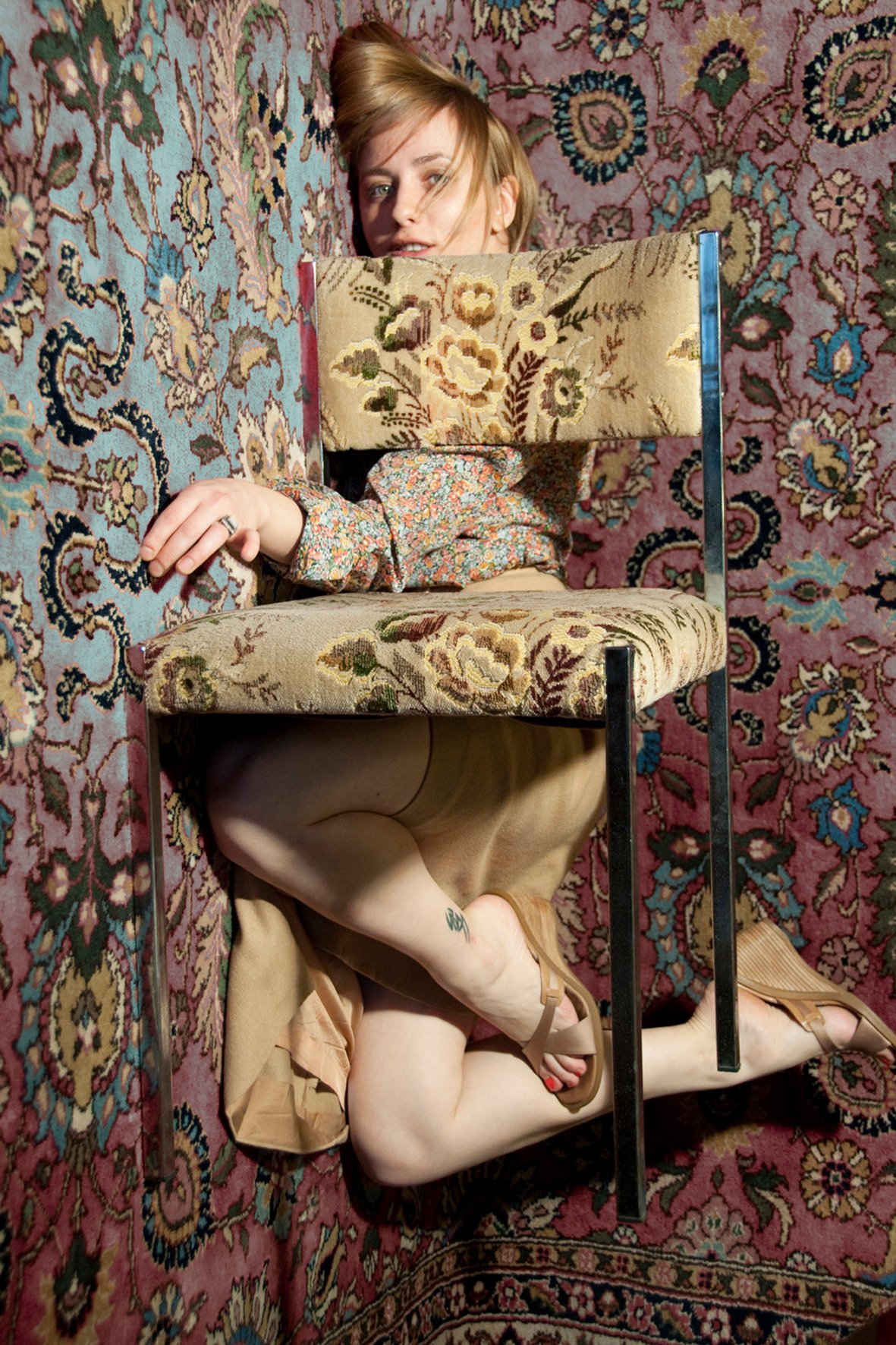II - The Digital Decade | 2010-2015 | memymom
ENG | The Digital Decade | 2010-2015
memymom’s first, self-published photo book appeared in November 2015. Entitled The Digital Decade, it contains photographs – all of them now shot and processed digitally – from series such as ‘The Baby Blues’ (2014), ‘Dusting off the Memory’ (2013), ‘La petite princesse’ (2012), ‘The Nurse’ (2012), and ‘Nunsense’ (2011). Lisa and Marilène frequently worked in series at this point; a reflexive awareness of their own practice had opened up, and they now approached projects for new photographs with a heightened degree of intent. One of the clearest examples in terms of this dimension (‘now we’re saying something about ourselves’) is the picture memymom Channels the Blues (from ‘The Baby Blues’ series), in which the women express the emotion that overcame them when they were unpacking photos for the 2013 exhibition that had been taken when the family was still complete.
When they compiled the book, though, Coolens and De Boeck did not stick to the series. Working in series did not mean that the individual images had lost any of their autonomous value and could not be shown separately; all the photographs in the book were included because of their own intrinsic worth. A different sequence of photos creates a different visual story and allows other meanings to emerge. This may be a detail, but it shows that memymom also work in a conscious way when publishing their oeuvre. What began as a casual game gradually developed into a conscious practice and a visual study in which not a single detail is left to chance – in other words, into art.
The difference between the ‘work’ in the first chapter, ‘The Umbilical Vein’, and that in the second chapter, ‘The Digital Decade’, goes beyond the differences between analogue and digital or single and serial work. Marilène – who, unlike her daughter, doesn’t like to be photographed and prefers to be shown unrecognizably – has now also become one of the dramatis personae. Brûlant Secret (from ‘The Baby Blues’ series) shows her from the back, while reading Stefan Zweig’s 1911 novel Burning Secret on a tablet. In the story, the 12-year-old Edgar befriends a man who wishes to seduce his mother in the hope of holding onto her attention. Lisa can now be found behind the camera too, or else she is no longer photographed alone. Mother and daughter, both unrecognizable, appear in the same image in Den Deugniet (Rascal, 2013). It goes without saying that a picture such as this generates a dramatic dynamism that wasn’t present in the images in the first chapter.
The locations used are another substantial change. All the images in ‘The Umbilical Vein’ are set in undefinable, fairly enclosed and improvised interiors, whereas the view in ‘The Digital Decade’ zooms out a little to reveal recognizable locations: a bedroom, a garden, a hotel room, a cemetery, a landscape. There is room on this broader stage for several characters. In The Bedroom (from the ‘Whodunnit’ series, 2012), for instance, Lisa appears up to five times in different guises, thanks to the possibilities of digital image manipulation. The second group of works is also wider thematically, with an explicit focus on motherhood, among other things. We see Lisa with a cuddly toy tied to her front, as if pregnant with her teddy bear, and as a veiled mother breast-feeding one of her four Liberty-clad dolls. Works such as this are memymom’s artistic, ironic responses to the clichéd questions posed by disconcerted people at the time of the first photographs, regarding what they saw as a collaboration between a mother and her daughter that went too far: ‘Won’t it take matricide to keep your relationship healthy?’
The reality is that we badly need memymom’s highly imaginative fiction. As Philip Roth put it: ‘The world of fiction ... in fact, frees us from the circumscriptions that society places upon feeling; one of the greatnesses of the art is that it allows both the [artist] and the [viewer] to respond to experience in ways not always available in day-to-day conduct; or, if they are available, they are not possible, or manageable, or legal, or advisable, or even necessary to the business of living. We may not even know that we have such a range of feelings and responses until we have come into contact with the work of fiction.’
NL | The Digital Decade | 2010-2015
In november 2015 verschijnt memymoms eerste, in eigen beheer uitgegeven fotoboek: ‘The Digital Decade’. De publicatie bundelt foto’s – ondertussen worden ze digitaal gemaakt en bewerkt - gekozen uit series zoals ‘The Baby Blues’ (2014), ‘Dusting Off the Memory’ (2013), ‘La petite princesse’ (2012), ‘The Nurse’ (2012) of ‘Nunsense’(2011).
In ‘The Digital Decade’ werken Lisa en Marilène inderdaad vaak in series. Er is een reflexief bewustzijn over de eigen praktijk opengegaan en projecten voor nieuwe foto’s worden nu vanuit een verhoogde intentionaliteit aangepakt. Een van de duidelijkste voorbeelden wat deze dimensie betreft (‘nu vertellen we iets over onszelf’), is het beeld ‘memymom Channels The Blues’ (uit de serie ‘The Baby Blues’, 2014), waarin de vrouwen uiting geven aan het lankmoedige gevoel dat hen overmande toen ze voor de tentoonstelling van 2013 foto’s uitpakten die werden genomen toen het gezin nog compleet was.
Coolens en De Boeck houden bij de samenstelling van het fotoboek evenwel niet vast aan de series. Het is niet omdat ze in series werken dat de afzonderlijke beelden aan autonome waarde inboeten en niet buiten de series kunnen. Alle foto’s komen in het boek voor wat ze op zichzelf waard zijn. Uit een andere opeenvolging van de foto’s ontstaat een ander beeldverhaal en kunnen andere betekenissen naar boven komen. Het is een detail maar het wijst erop dat memymom ook op het niveau van de publicatie van het werk bewust te werk gaat. Wat begon als een belangeloos spel ontwikkelt zich gaandeweg tot een bewuste praktijk en loopt uit op een beeldonderzoek waarbij geen enkel detail aan willekeur wordt overgelaten, met name kunst.
Het verschil tussen het ‘werk’ uit het eerste hoofdstuk, ‘The Umbilical Vein’, en dat uit het tweede hoofdstuk, ‘The Digital Decade’, overstijgt de verschillen tussen analoog en digitaal of tussen enkelvoudig en serieel werk. Marilène, die in tegenstelling tot haar dochter niet graag wordt gefotografeerd en liefst onherkenbaar in beeld komt, wordt nu ook een van de dramatis personae. In ‘Brûlant secret’ (uit de serie ‘The Baby Blues’, 2014) zien we haar op de rug terwijl ze op een tabletcomputer Stefan Zweigs gelijknamige novelle uit 1911 leest over de twaalfjarige Edgar die - teneinde haar aandacht te kunnen blijven genieten - vriendschap sluit met de man die zijn moeder wil verleiden. Lisa staat nu ook al eens achter de camera of wordt niet meer alleen geportretteerd. In ‘Den Deugniet’ (2013) spelen moeder en dochter, beiden herkenbaar, in hetzelfde beeld. Vanzelfsprekend ontstaat in een dergelijk beeld een dramatische dynamiek die nog niet aanwezig was in de beelden uit het eerste hoofdstuk.
Een andere aanzienlijke verandering betreft de locaties van de settings. Daar waar in ‘The Umbilical Vein’ alle settings in niet nader te bepalen, vrij afgesloten en geïmproviseerde interieurs spelen, zoemt de blik in ‘The Digital Decade’ enigszins uit en komen herkenbare locaties in zicht: een slaapkamer, een tuin, een hotelkamer, een begraafplaats, een landschap. Op dat verbrede podium is plaats voor meerdere personages. In ‘The Bedroom’ (uit de serie ‘Whodunnit’, 2012) bijvoorbeeld komt Lisa dank zij de mogelijkheden van de digitale beeldmanipulatie tot vijf keer toe in andere gedaanten voor.
Er zit in de tweede werkgroep ook thematische verruiming. Zo wordt er onder andere expliciet gewerkt rond moederschap. We zien Lisa met voorgebonden knuffeldier alsof ze zwanger is van haar teddybeer of als in sluiers gehulde moeder die een van haar vier in Libertystofjes geklede poppen de borst geeft. Dergelijke werken zijn memymoms beeldende, ironische replieken op de stereotiepe vragen die onthutste mensen naar aanleiding van de receptie van de eerste foto’s uitten aangaande de in hun ogen te verregaande samenwerking tussen een moeder en haar dochter: ‘Is er geen moedermoord nodig om jullie relatie gezond te houden?’
We hebben de verbeeldingsrijke fictie van memymom echter heel erg nodig. In de woorden van Philip Roth: ‘De wereld van de fictie bevrijdt ons […] van de beperking die de samenleving het gevoel oplegt; een van de grootste eigenschappen van de kunst is dat zij zowel de [kunstenaar] als de [kijker] toestaat om op ervaringen te reageren op manieren die niet altijd in de dagelijkse manier van doen beschikbaar zijn; of, wanneer ze beschikbaar zijn, zijn ze niet mogelijk, of niet te hanteren, of onwettig, of niet aan te raden, of zelfs niet noodzakelijk voor iets als het leven. We kunnen wel niet eens weten dat we een dergelijk scala van gevoelens en reacties hebben, tót we met de fictie in contact zijn gekomen.’
FR | The Digital Decade | 2010-2015
En novembre 2015, memymom publie à compte d’auteur son premier album photo: The Digital Decade. Cette publication rassemble des photos – désormais digitalisées – empruntées à des séries comme The Baby Blues (2014), Dusting Off the Memory (2013), La petite princesse (2012), The Nurse (2012) ou Nunsense (2011).
Dans The Digital Decade, en effet, Lisa et Marilène travaillent souvent en séries. Elles ont réfléchi à leur propre pratique et abordent leurs nouveaux projets de photos avec une intentionnalité accrue. En ce qui concerne cette dimension (« à présent, nous racontons quelque chose de nous-mêmes »), un des exemples les plus flagrants est la photo memymom Channels The Blues (de la série The Baby Blues, 2014), où les femmes expriment la souffrance qui les a submergées lorsqu’elles ont passé en revue, pour l’exposition de 2013, les photos de l’époque où la famille était encore au complet.
Dans la composition de leur album, cependant, Coolens et De Boeck ne s’en tiennent pas aux séries. Toutes les photos sont reprises dans le livre en raison de leur valeur intrinsèque. D’une autre succession surgit une autre histoire, chargée d’autres significations. C’est un détail, mais il rappelle que, chez memymom, la conscience s’exerce également au niveau de la publication de l’œuvre. Ce qui a commencé comme un jeu sans importance se développe progressivement en une pratique consciente et aboutit à une recherche d’images où aucun détail n’est laissé au hasard – c’est-à-dire à l’art.
La différence entre l’ « œuvre » du premier chapitre, The Umbilical Vein, et celle du deuxième chapitre, The Digital Decade, transcende les distinctions entre l’analogue et le digital, de même qu’entre l’unique et le sériel. Marilène, qui n’aime pas être photographiée, contrairement à sa fille, et préfère passer inaperçue, compte désormais parmi les dramatis personae. Dans Brûlant secret (de la série The Baby Blues, 2014), nous la voyons de dos, lisant sur une tablette la nouvelle homonyme de Stefan Zweig : l’histoire d’Edgar, âgé de douze ans, qui, pour ne pas être privé de l’attention de sa mère, se lie d’amitié avec l’homme qui cherche à la séduire. Et Lisa passe parfois derrière l’appareil ou n’est plus photographiée seule. Dans Den Deugniet (2013), la mère et la fille, toutes deux reconnaissables, jouent dans la même image. Il va de soi que la dynamique dramatique présente dans cette photo ne s’est jamais manifestée dans celles du premier chapitre.
Un autre changement décisif concerne les lieux des séances. Là où, dans The Umbilical Vein, toutes les séances se déroulent dans des intérieurs improvisés, non identifiables et majoritairement clos, dans The Digital Decade le regard fait une sorte de zoom arrière et des endroits reconnaissables apparaissent : une chambre à coucher, un jardin, une chambre d’hôtel, un cimetière, un paysage. Cette scène élargie peut accueillir plusieurs personnages. Dans The Bedroom (de la série Whodunnit, 2012), par exemple, Lisa apparaît jusqu’à cinq fois, sous d’autres formes, grâce aux possibilités de la manipulation digitale.
Le deuxième groupe d’œuvres se signale également par une extension thématique. Ainsi le travail se focalise-t-il explicitement sur la maternité. Nous voyons Lisa avec une peluche attachée contre sa poitrine, comme si elle était enceinte de son nounours, ou sous l’aspect d’une jeune mère enveloppée de voiles, donnant le sein à une de ses quatre poupées vêtues de tissu liberty. Des œuvres qui sont autant de répliques ironiques aux questions stéréotypées émises lors de la réception des premières photos par des spectateurs déconcertés, pour qui cette collaboration entre mère et fille allait trop loin: « Ne faudrait-il pas un matricide pour assainir votre relation? »
Pourtant, la fiction imaginative de memymom nous est indispensable. Selon les mots de Philip Roth : « Le monde de la fiction nous libère […] de la limitation que la société impose au sentiment; une des principales caractéristiques de l’art est qu’il permet à [l’artiste] comme au [spectateur] de réagir aux expériences de différentes manières, qui ne sont pas toujours accessibles dans la façon de procéder au quotidien; ou, si elles sont accessibles, elles sont impossibles, ou impraticables, ou illégales, ou déconseillées, ou même inutiles pour quelque chose comme la vie. Jusqu’à ce que nous soyons en contact avec la fiction, nous ne pouvons même pas savoir qu’il existe en nous une si vaste gamme de sentiments et de réactions ».
Jo Coucke, 2018


